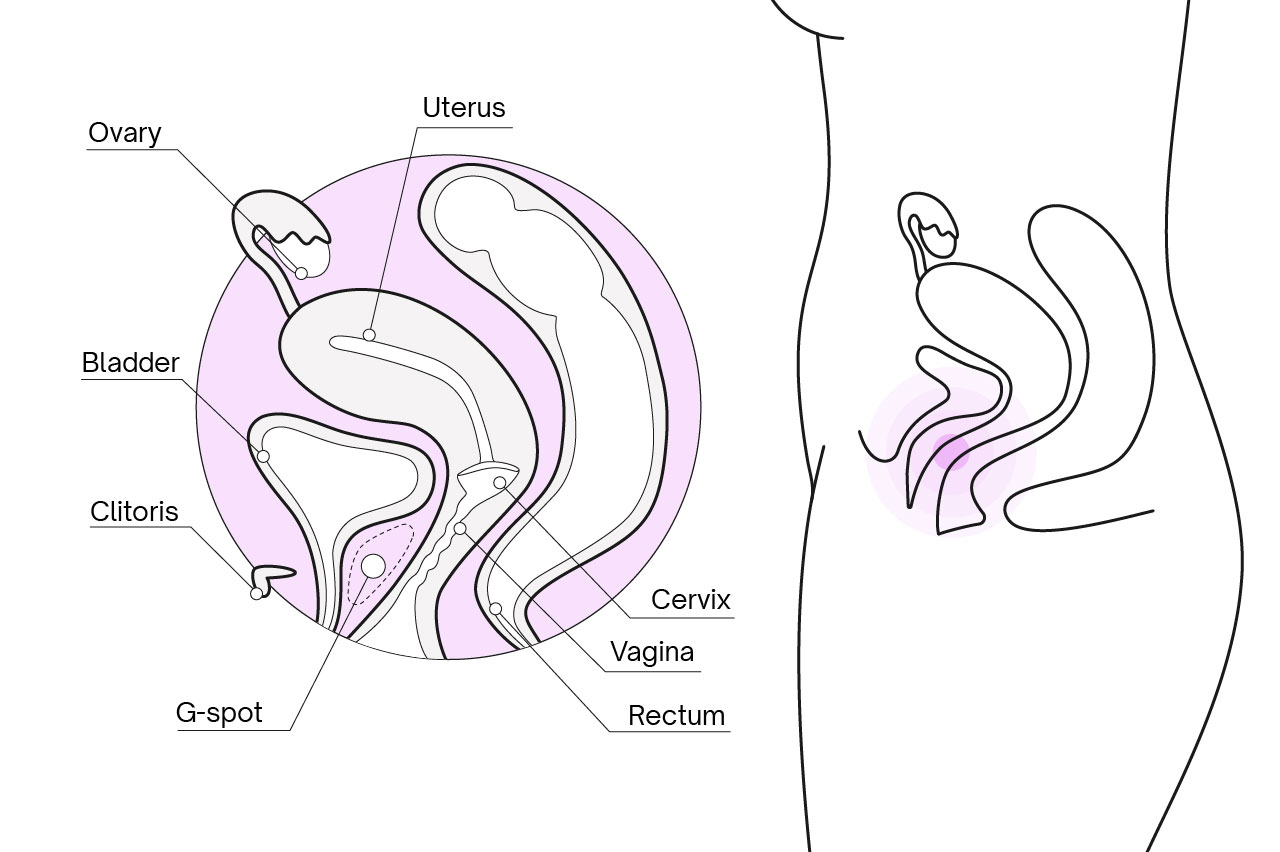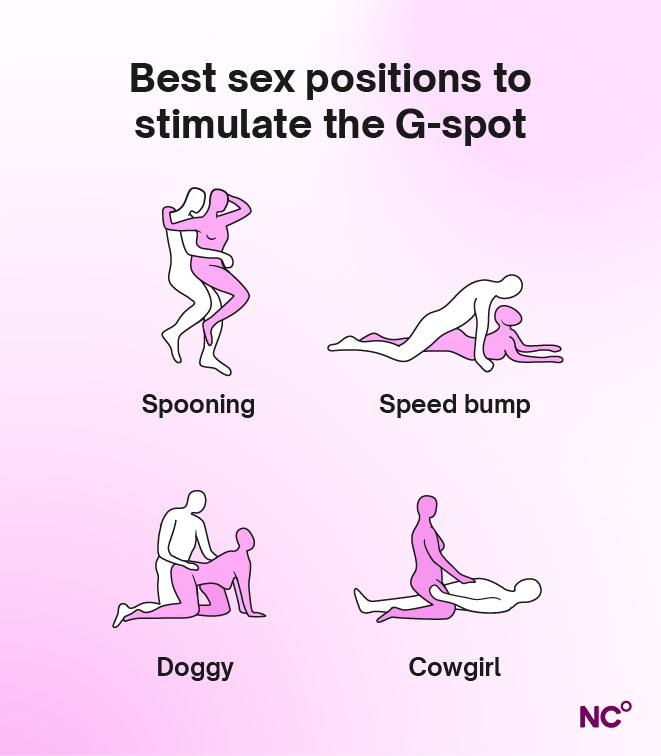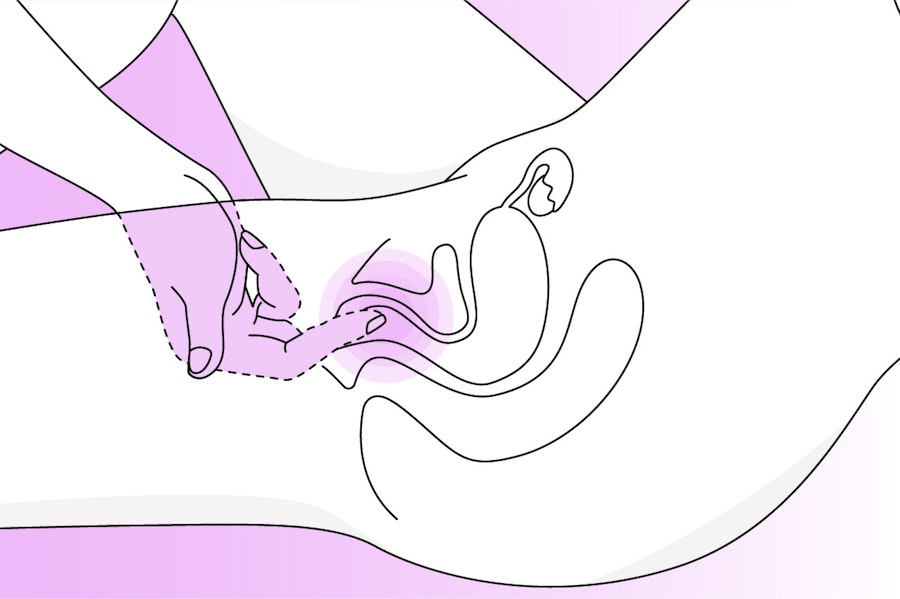G-spot: How to find it (diagram) & best sex positions to try
Follows NC° Editorial Policy
At Natural Cycles, our mission is to empower you with the knowledge you need to take charge of your health. At Cycle Matters, we create fact-checked, expert-written content that tackles these topics in a compassionate and accessible way. Read more...
Key takeaways:
- The G-spot is an area located on the anterior wall of the vagina that triggers sexual arousal and, for some people, an orgasm when stimulated
- It might be that the G-spot is not an independent spot but a part of the internal clitoral structure
- Some people might experience pleasure when their G-spot is stimulated, and some might not — every body is unique
While many of us have probably heard of the G-spot, we might not all know where the G-spot is. Despite being a small erogenous zone in our bodies, it is one of the most well-known areas. Yet even researchers are not quite sure whether it truly exists or not. If you're curious to learn more about the G-spot orgasm and how to stimulate this area for pleasure, read on.
What is the G-spot?
The G-spot is a zone or an area inside the vagina located on the anterior wall [1]. When this area is stimulated, it triggers sexual arousal. In the 1950s, German gynecologist Dr. Ernst Gräfenberg was the first medical professional to identify this area in a scientific article. This led to later authors referring to the anatomical area as the “Gräfenberg spot,” which became shortened to what we call today the “G-spot.” While the G-spot is famous for G-spot orgasms and squirting, it's a pretty controversial pleasure spot.
The G-spot has been studied from many angles by the scientific community, from medical imagery, anatomical explorations, cadaver dissections, and self-awareness surveys, but the data brings conflicting conclusions [4]. The researchers who believe in its existence argue that the G-spot is a sac with erectile-like tissue on the anterior wall of the vagina [2]. However, a more recent study found no anatomic evidence of such a structure [3], while yet another identified it in approximately half the bodies it investigated [4].
Finally, a 2021 systematic review on the G-spot notes that the G-spot might not be a separate pleasure spot but rather an area close to the internal part of the clitoris structure if it does indeed exist for a woman [5]. While scientists debate on the location, size, function, or even existence of the G-spot [5], no one can argue that vulvas and vaginas are full of sensitive pleasure areas that feel amazing when stimulated.
Where is your G-spot?
So, the G-spot indicates an area located about 2-3 inches or 5-8 centimeters inside the vagina [5]. However, the exact location might vary from person to person, as everyone's anatomy is slightly different.

It's important to note that not everyone experiences pleasure when stimulating their G-spot area. If you have little to no sensations when that area is stimulated or haven't experienced a G-spot orgasm, there's really no cause for concern. Our bodies are unique, and the erogenous zones that bring us pleasure can vary a lot!
How to hit the G-spot
Want to explore your pleasure zone and hit all the right spots? Whether solo or with a partner, we've got some hot tips to help you elevate your experience when stimulating your G-spot.
How to stimulate the G-Spot by yourself
When you're ready to dive into solo self-pleasure exploration and discover what feels good when you stimulate the G-spot, try:
- Warm up first: To have the most pleasurable experience stimulating the G-spot, it's important to dedicate time to foreplay before attempting penetration of any sort. So, spend some time warming up and building arousal. Play with the breasts and nipples, if that's something you enjoy, the clitoris and your vulva, and explore other erogenous zones on your body before diving inside.
- Add lubrication: When it comes to penetrative sex, it can be a good idea to add some lube, even if you have plenty of natural lubrication. It'll make things glide smoother and enhance the sensations, which will make the experience much more pleasurable. Some of the best lubes are water-based. There are advantages to using a water-based lube, such as how easily it cleans up and that it doesn’t stain clothes or sheets. They're also great if you have sensitive skin since they won't cause irritation. To use, apply a bit to your fingers, the sex toy, or directly on the vulva. You can re-apply more lube later if you feel like you need it.
- Find the right type of stimulation: As we already discussed, the G-spot is located a few inches inside the vagina, on the anterior wall. Slide one or two fingers inside and make the "come here" motion to explore how it feels when you touch that area. Be patient with yourself and open to experimentation. It might take some time to find the most pleasurable stimulation. You might want to play around with the speed — go slower and faster, or alternate between the two speeds. It might feel better to draw circles around the area or go side to side rather than gesturing "come here" with your fingers. Experiment and have fun!
- Play with pressure: Pressure might be the key to getting the most out of G-spot stimulation. As you stimulate the area, start by applying a little pressure and then increase it as you go.
How to stimulate your partner's G-spot
Want to blow your partner's mind with a G-spot orgasm? Take note of these suggestions:
- Explore their body first: Our bodies are full of erogenous zones that feel amazing when stimulated. Before you even attempt to stimulate the G-spot, spend time showering your partner's body with gentle touches, caresses, and kisses to turn them on. Once they're aroused and fully in the zone, dive into the G-spot stimulation.
- Use your words: Did you know that our brains are our biggest sex organs? Use this fact to your advantage when playing with your partner! As you explore their body, tell them how aroused you are by their presence, how good they taste or smell, and how much you want to please them. A simple "I love to hear you moan" can make a huge impact on your partner's arousal.
- Check-in with them: Not sure if the type of stimulation is working? Have trouble reading your partner's body cues? Ask them! You'll have the best experience if you communicate during exploration. As you try different types of touch, gently ask your partner, "Does that feel good, baby?"
- Take your time: G-spot orgasms may take longer than clitoral orgasms for some people. Generally, female orgasms tend to become elusive when there are expectations involved. So, help your partner feel as relaxed as possible by taking your time exploring their body. Get comfortable, and go slow.
- Consistency is key: For many people, the key to achieving orgasm is erogenous stimulation, finding what feels good, and staying with it until you climax. Once you know what type of touch and stimulation feels the best for your partner, stick with it until they reach an orgasm.
- Communicate: Whether you choose to stimulate your G-spot with a partner present, or if they are the ones doing the stimulation, having clear and open communication is so important. Be very clear to your partner about what sort of stimulation feels the best, and ask them to continue what they're doing if it feels great, so they don’t end up switching up the stimulation types at the worst moment.
The best sex positions to stimulate the G-spot
Some sex positions might work better than others for direct G-spot stimulation. The best positions will be those that give you the most control over the hip movements and access to the clitoris and offer an angle where the anterior wall of the vagina receives the most stimulation. Here are four that combine all four elements you might want to try.
1. Spooning
The spooning position is great because of the angle — when in the position, the penetrating partner hits the anterior wall over and over again, right where the G-spot area should be. In this position, the receiving partner has the freedom to move their hips to add more stimulation. Both partners have easy access to the clitoris, which can greatly enhance pleasure.
To get into this sex position, both partners lie down on their sides, just like they would when they're cuddling. The penetrating partner is behind the receiving partner, and they enter from behind.
2. Speed Bump
The speed bump sex position offers a great penetration angle where the penetrating partner hits the anterior wall repeatedly, exactly where your G-spot should be. It's also a position with easy clitoris access for extra stimulation. You might place a pillow under the hips to lift them higher if you desire a deeper penetration angle.
To get into this position, the receiving partner lies down on their stomach, and the penetrating partner settles on top of them and penetrates from behind. The receiving partner might keep their legs spread wide or keep them together. Both partners can slip a hand around the receiving partner to stimulate their clitoris to enhance the pleasure.
3. Doggy
Doggy style is very versatile and works wonders for G-spot stimulation. It gives both partners plenty of control over the depth and angles, and it has many variations. Also, it gives easy access to the clitoris to help make sex more pleasurable for the receiving partner.
To get into this sex position, the receiving partner gets on all fours. The penetrating partner kneels (or stands) behind them and enters. If the receiving partner arches their back in this position, it might offer more direct anterior wall stimulation. If the receiving partner gets on their forearms instead of their hands, it deepens the angle of penetration. It's a good idea to play around with different variations to find one that works best for you.
4. Cowgirl
The cowgirl sex position gives a lot of control to the receiving (or top) partner over the movements, depth of penetration, and speed. To get the most out of this sex position for G-spot stimulation, instead of moving up and down, the top partner wants to focus on moving back and forth.
To get into this position, the penetrating partner lies down on their back. The receiving partner straddles their hips, facing them. The bottom partner might lie still and allow the top partner to do all the work, or they might thrust their hips up. Both partners have access to the clitoris in this position for more pleasure.

Are G-spot orgasms more powerful?
It's difficult to say whether G-spot orgasms are more powerful than clitoral orgasms because of the conflicting evidence about G-spot existence and nature. Some individuals report that vaginal orgasms do feel different — they last longer, feel more intense and deeper, and give a whole-body experience [6].
However, if the G-spot is an internal stimulation of the clitoris, as some scientists suspect, the orgasms it causes would be clitoral instead of vaginal. As long as you’re having a good time, it doesn’t really matter if one orgasm is more powerful than another. Just do what feels right for you.
Can stimulating your G-spot help you squirt?
Squirting is a release of a clear fluid caused by stimulation of the female genitals [7]. It might or might not induce or accompany an orgasm, and not all people experience it — a study in the United States found that around 40% of women reported having ever squirted [8].
It's a common belief that G-spot stimulation is the way to achieve squirting, but it's not as simple as that. In the same survey in the United States, different techniques were mentioned to help experience squirting, including pressure inside the vaginal wall and clitoral stimulation on its own [8].
Reasons some people can’t orgasm from G-spot stimulation
While stimulating the G-spot can be a source of great pleasure for some, others may not feel much at all in that area. First of all, know that if you don't experience many sensations from G-spot stimulation, it's completely normal. There's nothing wrong with you or your body.
Sexual pleasure is highly individual, and there are a few different reasons why some people may not be into G-spot stimulation, such as:
- Anatomic differences: Because our bodies are unique, anatomical variations such as the thickness of the anterior vaginal wall, the distance between the clitoris, vaginal opening, and urethra, and even erectile tissue differences can influence whether or not you feel sensitivity in the area.
- Different stimulation preferences: Not all types of stimulation are effective for every person. You may notice that solo G-spot stimulation is easier than with a partner, which may influence whether or not you enjoy G-spot orgasms during penetration.
- Hormonal fluctuations: The hormonal swings we experience over the course of our cycles may affect how sensitive and responsive we are to certain types of stimulation.
- Psychological factors: For some people, an orgasm is much more than manual stimulation. Factors such as stress, anxiety, relationships, and feeling connected to their partner can have a great impact on their sexual arousal and orgasmic abilities [9].
Before you decide G-spot orgasms are something you can’t achieve, you may want to change your perspective. It may be that G-spot orgasms are elusive for you because you focus too much on stimulating one small specific spot. In reality, the G-spot may be a complex, dynamic structure that looks and feels different for you than for someone else. To enjoy the full potential of G-spot pleasure, you may need a wider type of stimulation that includes internal areas around it, and even adding in a clitoris.
Other erogenous zones worth stimulating
G-spot is not the only area in our bodies that feels good when stimulated! We're lucky to have quite a few erogenous zones (genitals and not) that can bring a ton of pleasure for us.
Aside from the G-spot, here's a list of other potential erogenous zones to explore [10, 11]:
- Lips
- Nipples
- Breasts
- Clitoris
- Anus
- Perineum
- Nape of the neck
- Ears
- Toes
- Inner thighs
- Lower back
- Stomach
- Shoulders
- Head
Everyone's bodies are different, so what may feel good for one person may not have give any pleasure to another. So, as you pleasure map your body, keep an open mind!
Learn more about your body with Natural Cycles
Increasing awareness about female health is key to our mission here at Natural Cycles. Our FDA Cleared app can help you plan or prevent pregnancy and learn more about your body and pleasure. Try it to discover if Natural Cycles is right for you!
Did you enjoy reading this article?
